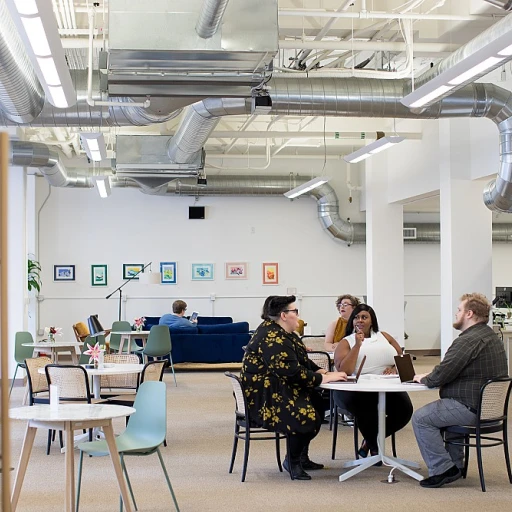
Understanding the Role of HR in Employee Engagement
HR's Critical Role in Cultivating Employee Engagement
Human Resources plays a pivotal role in shaping the landscape of employee engagement within an organization. By fostering an environment where employees feel valued, HR contributes significantly to job satisfaction and engagement levels. The engagement impact extends beyond just retaining talent – it enhances performance, encourages innovation, and builds a cohesive teams culture. HR departments are often tasked with the creation and implementation of programs designed to engage employees. These initiatives can range from peer recognition systems to development opportunities that support career growth. Effective leaders understand that engaged employees are more likely to demonstrate commitment to their roles and contribute positively to the organizational goals. Regular feedback is a cornerstone of engagement strategies. Through continuous check-ins and 360-degree feedback mechanisms, managers can reinforce transparent communication, allowing employees to feel heard and appreciated. By doing so, the employee experience is enriched, leading to a more engaged workforce and ultimately providing a competitive advantage. In the age of artificial intelligence, the role of HR is also evolving to include leveraging technology to improve the employee experience. Digital platforms enable HR to gather data-driven insights that inform decisions around flexible work arrangements and remote work – elements that are increasingly important to today's workforce. By understanding these dynamics, HR can effectively support employees, motivate teams, and drive the organization towards success. For those looking to deepen their understanding of this vital role, check out how to enhance your recruitment strategy with a newsletter here for more insights.Effective Candidate Sourcing Strategies
Smart Recruitment Tactics to Boost Engagement
Finding and attracting talent who will become engaged employees is crucial for any organization that aims to thrive in today's competitive job market. Implementing effective candidate sourcing strategies can create a significant impact on the overall employee engagement levels. One of the keys to successful candidate sourcing is understanding the link between how potential candidates are approached and how they eventually feel about their roles and the teams they join. By employing targeted sourcing techniques, companies can identify individuals who not only possess the desired skills but also share the organization’s values and culture. This alignment can lead to higher engagement, job satisfaction, and a more engaged workforce over time.Adopting Innovative Sourcing Methods
Incorporating a mix of traditional and modern sourcing strategies can give hiring managers access to a broader pool of candidates.- Utilizing employee referrals: Encouraging existing employees to refer potential candidates can help build a team that is not only skilled but also aligned with existing cultural values.
- Engaging passive candidates: Reaching out to individuals who may not be actively seeking a job change but have the skills and experience needed for a role can lead to finding talent that might otherwise be inaccessible.
- Leveraging social media platforms: Using platforms such as LinkedIn for targeted searches and networking can facilitate connections with potential hires who match the ideal candidate profile.
- Advanced sourcing tools: Utilizing artificial intelligence and data-driven tools can streamline the process of identifying suitable candidates quickly and efficiently.
Expanding Flexible Work Arrangements
Adopting flexible work and remote work arrangements can enhance the appeal of open roles to a diverse group of potential employees. These flexible options not only attract a varied talent pool but also support employee engagement once candidates join the organization. Recognizing that employees feel valued and trusted when given autonomy over their work schedule can lead to enhanced performance and retention.Ensuring Transparent Communication
From the very first interaction, clear and transparent communication sets the tone for the type of relationship candidates and employees will have with the organization. As potential team members interact with managers and leaders during the recruitment process, it is imperative to communicate expectations and company culture honestly. This transparency helps build trust and contributes positively to the employee experience once they are on board. Incorporating these strategies into your recruitment efforts not only helps reach better-matching candidates but also lays the foundation for a thriving, engaged workforce. For more insights on enhancing your recruitment strategy, visit enhancing your recruitment strategy with a newsletter.Building a Positive Workplace Culture
Creating a Collaborative and Positive Office Atmosphere
Building a positive workplace culture is essential in cultivating an engaged workforce that thrives both in productivity and job satisfaction. When employees feel valued and supported, their engagement levels naturally increase, leading to higher performance and overall organizational success. A crucial way to foster this environment is through recognition and appreciation. Implementing peer recognition programs and offering regular feedback can significantly impact employee motivation and commitment. Engaged employees are more likely to take ownership of their roles and contribute positively to team dynamics. In addition, the ability to nurture transparent communication and flexible work arrangements is paramount. With the rise of remote work, providing options for flexible work and clear communication channels can help employees feel connected and supported, enhancing their overall employee experience. Moreover, managers and leaders need to set a precedent by offering continuous support and development opportunities. Regular check-ins, perhaps through degree feedback mechanisms, enable managers to gauge engagement levels and address any issues proactively. These programs play an essential role in reducing turnover and increasing employee loyalty. Finally, using data-driven insights and innovative technologies like artificial intelligence can aid in tailoring engagement strategies to individual and team needs. By aligning technological advancements with human-centric principles, organizations can create a competitive advantage, ensuring employees feel genuinely recognized and valued. To further support and nurture a thriving workplace culture for the future, it is vital to address staffing needs strategically; learn more here.Leveraging Technology in HR Processes
Boosting Efficiency with Technological Advancements in HR
Technology plays a pivotal role in transforming HR processes, leading to enhanced employee engagement and job satisfaction. By embracing digital solutions, companies empower their leaders and managers with the tools needed to foster an engaged workforce. Integrating platforms that streamline communication and administrative tasks can significantly impact engagement levels. For instance, implementing systems that offer regular feedback and performance tracking helps employees feel more connected to their roles and responsibilities. These digital feedback mechanisms, such as degree feedback, allow for transparent communication and robust employee engagement. Furthermore, leveraging artificial intelligence (AI) in HR processes simplifies candidate sourcing and recruitment. AI-driven platforms can analyze data to identify suitable candidates faster, saving time while focusing on creating a positive candidate experience. This approach aligns with strategic HR management and ensures a competitive advantage in attracting top talent. Flexible work arrangements, supported by technology, cater to the evolving needs of the modern workforce. Remote work solutions not only provide development opportunities but also create environments where employees can thrive regardless of their location. By supporting diverse work arrangements, companies can build teams that are both efficient and motivated. Another technological advancement is the introduction of employee recognition programs. These programs, facilitated by digital platforms, allow peer recognition to flourish and help employees feel valued for their contributions. Recognizing achievements in real-time enhances motivation levels and strengthens team dynamics. Finally, comprehensive HR systems gather valuable insights into employee experience through data analytics. This empowers managers to make informed decisions, continuously improving engagement levels and contributing to an engaged workforce. By harnessing technology, companies can provide continuous support and development tailored to individual needs, ultimately ensuring higher job satisfaction and performance. In summary, the strategic use of technology in HR not only enhances the employee experience but also fosters an environment that promotes regular communication, flexible work, and meaningful feedback. This holistic approach supports the establishment of an engaged workforce, laying the groundwork for long-term success.Continuous Feedback and Development
Creating a Culture of Continuous Feedback
In the realm of employee engagement, continuous feedback is a cornerstone that helps employees feel valued and understood. Regular feedback sessions, often referred to as check-ins, provide managers with the opportunity to discuss performance, development opportunities, and job satisfaction with their teams. This transparent communication builds trust and supports an engaged workforce.
Implementing 360-Degree Feedback
360-degree feedback is a powerful tool that involves collecting feedback from various sources, including peers, leaders, and even subordinates. This comprehensive approach offers a well-rounded view of an employee's performance and impact within their role. By incorporating diverse perspectives, organizations can create a more inclusive and supportive environment that fosters employee engagement.
Leveraging Technology for Feedback and Development
With the rise of artificial intelligence and other technological advancements, HR processes have become more streamlined and efficient. These tools can be used to gather data on employee engagement levels and provide insights into areas that need improvement. Additionally, technology can facilitate remote work arrangements and flexible work options, which are increasingly important for maintaining an engaged workforce.
Recognizing and Rewarding Performance
Recognition programs play a crucial role in enhancing employee experience. When employees receive recognition for their contributions, it boosts morale and reinforces positive behaviors. Peer recognition, in particular, can have a significant impact on team dynamics and overall engagement levels. By celebrating achievements, organizations can build a culture of appreciation and motivation.
Supporting Development Opportunities
Development opportunities are essential for keeping employees engaged and motivated. By offering training programs, mentorship, and career advancement paths, organizations demonstrate their commitment to employee growth. This not only enhances job satisfaction but also helps in retaining top talent, giving companies a competitive advantage in the market.
Measuring and Improving Engagement Levels
Evaluating and Uplifting Workplace Engagement
Effectively measuring and enhancing engagement levels is pivotal in developing an engaged workforce. Key methods to achieve this include ongoing performance evaluation and fostering a supportive work environment. Regular feedback and check-ins play a crucial role, as they not only facilitate transparent communication but also allow for timely recognition and adjustment.- Feedback Utilization: Managers should harness the power of feedback to create development opportunities. Constructive feedback, whether through formal performance reviews or more informal check-ins, helps employees feel valued and understood. This understanding contributes to job satisfaction and boosts engagement.
- Role of Data: Leveraging data is becoming increasingly important in tracking engagement levels. Organizations can utilize data from employee surveys, degree feedback systems, and other analytical tools to assess the well-being and satisfaction of their teams. This information guides strategic HR decisions that support an engaged employee experience.
- Creating Recognition Programs: Peer recognition and reward programs reinforce positive behaviors and build a culture of appreciation. When employees receive acknowledgment for their efforts, their motivation and commitment to their roles are enhanced, leading to an overall lift in engagement.
- Flexible Work Arrangements: The shift towards flexible work, including remote work options, requires close monitoring to ensure engagement remains high. By accommodating diverse work arrangements, leaders can nurture engagement by aligning work environments with employees' needs, ensuring they remain engaged and productive.
- Enhancing through Leadership: The impact of leaders on engagement cannot be overstressed. Leaders must be equipped to provide support through strategic HR management, promoting an environment where employees feel empowered and motivated to contribute to the company’s success.












